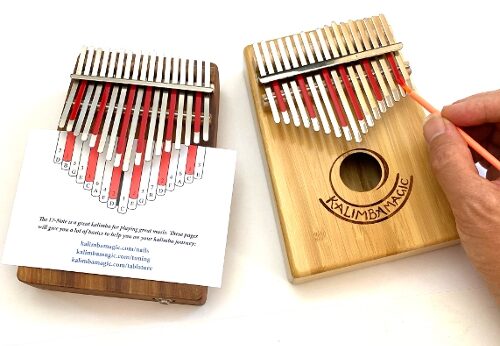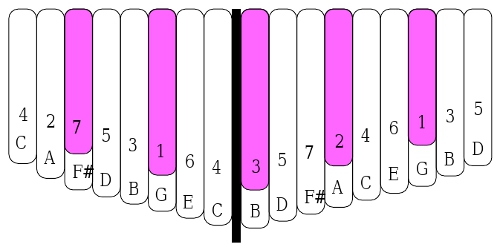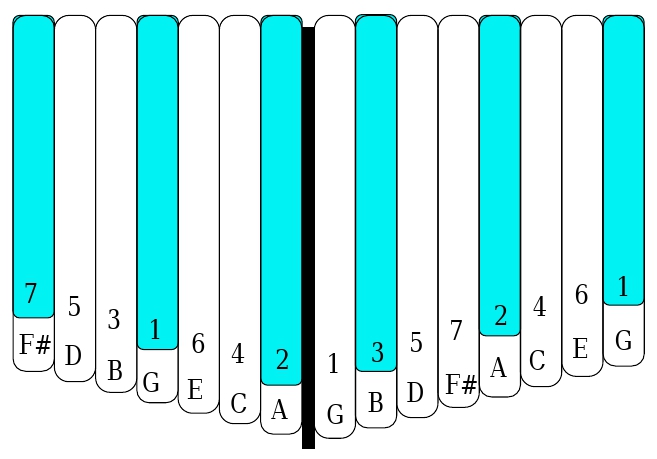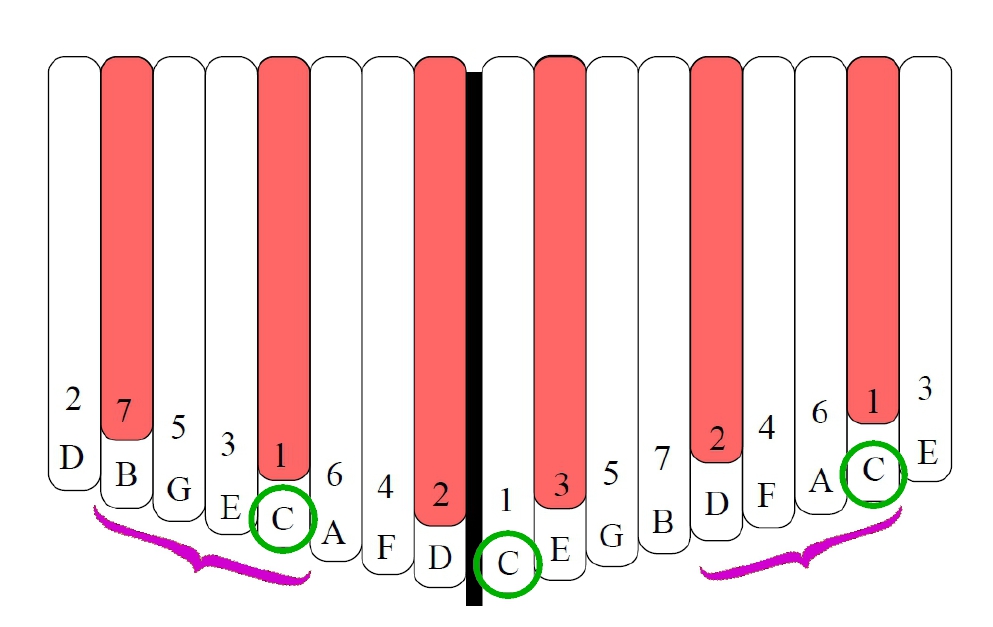
The 6-painted tine system is our standard.
Our tuning insert is set up that way.
My personal 17-Note Kalimbas in C are painted that way.
The books I write have 6-painted tine tablature.
But not every 17-Note Kalimba is painted this way.
 The Original Hugh Tracey 17-Note Treble Kalimba, I paint the same way that Hugh Tracey painted in 1954. Why? Because it has always been painted that way.
The Original Hugh Tracey 17-Note Treble Kalimba, I paint the same way that Hugh Tracey painted in 1954. Why? Because it has always been painted that way.
When people pick up a Hugh Tracey Treble Kalimba, and see the middle tine painted, they realize that is the 3rd of the scale. After that lowest tine is paint, as you ascend each side, every third tine is painted. And, if your kalimba is tuned this way and painted this way, it works with the Treble Tablature-based books I have been making since 2005.
Why does a large part of the world paint their 17-Note kalimbas with the 5-painted-tine system? Because around 2017, the Chinese manufacturers copied the Hugh Tracey Treble Kalimba. They copied the box size and shape. They copied the sound holes, front and back. Then they copied the tine lengths and widths, and they copied the way the tines were painted. But they changed the tuning. Copying the way the tines are painted and changing the tuning results in a kalimba that LOOKS like a Treble Kalimba, but cannot read any Treble Books.
I decided to hold my ground all these years, and keep producing books as I have now for 16 years. One positive effect of this is that when Chinese companies pirated my works, they no longer work for the new 17-Note in C with the 5-painted-tine system.
I will start with the Alto Kalimba. The Alto has 15 notes and is in the key of G. However, it has the root note, G, in the bass. That means the lowest note on the kalimba is “Do” of “Do Re Mi Fa So La Ti Do” = “1 2 3 4 5 6 7 1”.
 Look at the painting system and tuning of the Alto Kalimba. Why does it have an F#? Because the key of G requires an F#, not an F natural. It won’t sound right without an F#.
Look at the painting system and tuning of the Alto Kalimba. Why does it have an F#? Because the key of G requires an F#, not an F natural. It won’t sound right without an F#.
The painted tines are landmarks, helping you find your way. They are also a way to interleave the left and right sides of the kalimba. Look at the central three tines, G, A, and B. You can see that the A tine is a bit longer than the B tine, and will be lower. The painted tines come in pairs: low A and B; middle G and A; and high F# and G. In each pair, the left painted one will be one note lower than the right painted tine. This helps immensely when playing scales or scale fragments.
There are three G notes on the kalimba, and they related to painted tines in important ways. The painted tines kind of make a target, and the low G is the central point on that target. The middle G on the left is itself a painted tine. And high G on the right is also a painted tine. When you are looking frantically for the root note, it is really easy to find, high, middle, or low.
 17-Note Kalimba in C
17-Note Kalimba in CWhen I paint a 17-Note Kalimba in C, the 6-painted tine system of the Alto is my standard. (We will paint for you in the 5-painted tine system, but you have to request it.)
Why is the 6-painted tine system my standard setup? Because logically, this is the same instrument setup as the Alto. It has the root note (C now) in the bass, and that C is surrounded by two painted tines. The middle C on the left side is painted, and the high C on the right is painted. This makes it very easy to find a C, the root note. And it brings the 17-Note Kalimba in C into the system that all of my tablature and kalimba books live within.
But also check this out. The lowest octave is actually pretty easy to play correctly, because your tines are pretty close to the center. You can actually see that the low D tine is a bit longer, and the low E tine is a bit shorter. To top off the easy in the lower octave, it ends on C, a painted tine. Where you really need the help is in the second octave, because the tines you need to play to make adjacent notes in the scale are increasingly further apart.
That upper octave is bracketed by the four upper painted tines, making it really easy to find! The upper octave starts on left painted C, followed by right painted D. Then four unpainted tines, and we bookend the octave with the left painted B and the right painted C. The two upper pairs of painted tines start on the middle C and end on the high C. The high D and E are just for gravy – they are very useful in many melodies, so it is quite nice to have them.
Giving credit where credit is due, this is the system that Hugh Tracey first created on his Treble and Alto kalimbas in 1954. And I happily play within this system and honor its inherent logic today in 2021.
This video shows you how you can use 6-painted tine tablature with your 5-painted tine kalimba… and vise versa.
Even though I use a different tine painting system, several of my kalimba works have been pirated. It is really sad – I invented kalimba tablature, I taught the world to play kalimba, and now my business is being run into the ground.
If you would like to help me, I invite you to share my YouTube videos or Kalimba Magic blog posts on your favorite social media. Follow me on TikTok. From 2008 to about 2013, my kalimba videos got millions of views, and were the top ranked search results on YouTube and Google. Now, when I create a new Kalimba video on YouTube, I celebrate after a few months if they hit 1000 views. Lets just saw that I am paddling up river and it is not easy to do, and any help you can give me is greatly appreciated. I know I have a great deal of value to share with the world, but my message is being drowned out.
But enough griping! Here I share with you some inherent reasons why the 6-painted-tine system makes sense for you, totally apart from history and my big collection of kalimba books.
New Resources for 17-Note Kalimbas with “5-painted tine system”


Sign up for our newsletter and free resources with your email address:
We pinky promise not to spam you and to only send good stuff.
 Christmas in July 2025
Christmas in July 2025 Patriotic and American Music for Kalimba
Patriotic and American Music for Kalimba